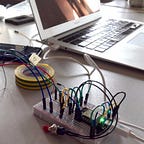Part 7: The final presentation
We all have limits to our abilities — physical, social, emotional and cognitive. How can we design to embrace these universal things that make us human, but also create solutions that are highly adaptive to an individual person?
We as designers can help to remove obstacles, enabling people to participate in society no matter their individual challenges. Let’s imagine a future that puts human empathy at their design core!
This is a work-in-progress documentation of a design project on the topic of inclusion and technology. We as a group of design students are working on design for the blind as part of a collaboration between Microsoft Research and University of Applied Sciences Potsdam. More background information at the bottom.
A lot to prepare
The past weeks have been quite a rush. Since the midterm presentation, we shaped our concept, build the user flows and visuals for the Polo app, shot a movie illustrating Polo from the user perspective and even managed to downsize the entire working prototype to a small, off-the-shelf wristband.
With two more days left, we had plenty of time to prepare for the final presentation. Which had to be a blast, given the fact that Andreas Koller and Don Coyner from Skype will be the jury. It is on them to decide which design team will be allowed to join the Microsoft Design Expo 2015 and Imagine Cup in Redmond, Washington.
The final presentation
On May 21st, we were set up for the final presentation. Luckily we practised a few times prior to that, making up for a smooth talk with only minor — but funny — slip of the tongue :-)
But see the live recording yourself to decide whether we managed to bring Polo across to the audience or not!
Outcome & Results
Don and Andreas found the presentation to be really well prepared. They especially liked the video, which they said was great.
On the other hand they had a few questions on the backend technology which they didn’t quite get from the presentation. Appareantly we have to try to bring that across more precisely and easily to grasp.
After each of the six design teams has had held their presentation, Don and Andreas retreated into another room, debating over which team will be the winner.
It was a very close race, but in the end, we didn’t make it. Tracktile, a concept for custom-made tactile maps, was selected by Microsoft to be presented at the 2015 Design Expo — together with the projects developed at seven other design universities from all over the world.
Kudos to the winning team!
Thanks to our partners
We would also like to take the opportunity to say thank you to all of you who supported us along the process, namely
— Boris Müller, head of design department of the University of Applied Sciences Potsdam for instructions and feedback — Elke Urban of the Institute for Haziness for hands-on insights on living with vision impairments — Michaela Franke, who works as a rehabilitation coach for the visually impaired, for providing an expert’s point of view — The Bio Company for allowing us to shoot a movie in their organic grocery store at Nedlitzer Straße 19, 14469 Potsdam — Richard, Don and Andreas vom Microsoft and Skype for the opportunity to take part in the inclusive design challenge and providing feedback
Many thanks!
Visit polo.band
Don’t forget to visit our project’s website at www.polo.band !
That was it
This is the last chapter in a series of seven, accompanying the design process during the past three months. Thanks a lot for your interest in reading.
Previous Chapter
Part 6: Shooting a movie
Part 5: The Midterm presentation
Part 4: Ideation & Prototyping
Part 3: Interviews and User studies
Part 2: Research
Part 1: Exploration
Appendix
What is this about?
Inclusion is a relevant and up-to-date topic widely debated recently. The WHO revised their definition of disability, shifting it from a fixed attribution to a context sensitive consideration. We as designers can help to remove obstacles, enabling people to participate in society no matter their individual challenges. A human centered design approach with deep research and observation, rapid prototyping and cheaper yet more powerful technology can make quite an impact.
Each year, Microsoft Research sponsors a semester-long class at leading design schools. This year’s design challenge is about Inclusive Design & Technologies. Let’s imagine a future of adaptive systems that puts human empathy at their design core.
We as students from the design department of University of Applied Sciences are taking part in this global design event. The leading teams will be presenting their ideas at Microsoft Design Expo 2015 in Redmond, USA.
The designer behind the project
This is a project by Philipp Steinacher, Dominic Rödel, Laurids Düllmannand Henrik Hagedorn. We study interface design at the University of Applied Sciences Potsdam.
Read more
The website of Microsoft Research Design Expo 2015 provides in-depth information on the overall project.
